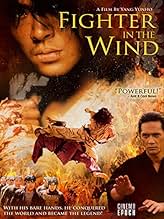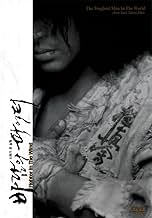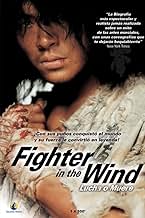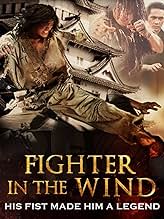CALIFICACIÓN DE IMDb
6.9/10
4.3 k
TU CALIFICACIÓN
Agrega una trama en tu idiomaIt is a Korean boy who went to Japan and started to learn Karate from his brother.It is a Korean boy who went to Japan and started to learn Karate from his brother.It is a Korean boy who went to Japan and started to learn Karate from his brother.
- Dirección
- Guionistas
- Elenco
- Premios
- 1 premio ganado y 2 nominaciones en total
Kim Won-shik
- Boy
- (as Won-sik Kim)
- Dirección
- Guionistas
- Todo el elenco y el equipo
- Producción, taquilla y más en IMDbPro
Opiniones destacadas
OK, first things first; this is NOT a martial arts kung-fu beat em up movie (If you want that, go watch Ong-Bak!). Throw those expectations OUT and prepare to enjoy a very gripping action/drama with some of the most beautiful filmwork i've seen in a while. To keep it simple, this movie is very exaggerated biography of Choi Baedal (Later changed his name to Mas Oyama), founder of Kyokushin karate, starting from before WW2. The fight scenes are not like standard kungfu flicks. They don't fight for 5 minutes. It's realistic in this sense. They trade a few blows and one or the other falls down in severe pain. This movie screams of a comic book feel. Fight scenes are stopped in mid-action to emphasize the form and the impact of the blows, the color and framing of each shot is reminiscent of comics as well. It emphasizes Choi Baedal's super-heroish qualities. The storyline is very interesting, although it runs a little long. Overall, its a very beautiful film to watch. Its great to see a movie really focus on the philosophies and ideas of martial arts rather than just the fighting itself. It also deals with the fears mindset of a fighter. Its VERY sad, and can sometimes come off as corny, but the overall emotional impact is there. Watch it, and remember, its NOT a pure kung fu beat em up movie and you will enjoy it.
'Paramui Paito (Fighter in the Wind) is based on the events in the life of legendary Korean martial artist Choi Bae-dal. Or more precisely, the film is based on the comic book based on the martial artist's life _ a difference that can be felt throughout this entertaining but factually suspect movie.
The first of a handful of local films about famous Koreans who lived during the Japanese occupation period, ''Fighter in the Wind tells of the early part of Choi¡¯s life, how he sneaked into Japan in the late 1930s in hopes of becoming a pilot, joined the martial arts community there, and after training by himself in the mountains for 18 months, came down to become the top fighter of that country.
The film offers a seemingly sentimentalized version of the same story, especially playing up the outsider aspect of Choi's experiences, of his being a Korean in Japanese society. Given the story's xenophobic elements, which include evil yakuzas exploiting Koreans, it will be interesting to see how a Japanese audience responds to the film when it gets released there as planned.
''Fighter¡¯s best moments hint at the moral complexity of films like ''Raging Bull,¡¯¡¯ Martin Scorcese¡¯s boxing masterpiece. At first, Choi¡¯s motivation to become Japan¡¯s best seems to be connected to righting injustices felt by Koreans in Japan, but as he travels to martial arts schools enduring punishment after punishment, it becomes less clear as to what he is trying to prove.
But such insights are all too brief in the film, which is so heavy on the melodrama and action that it's difficult to take too seriously. By the end, the story resembles a kung fu film from Hong Kong, complete with a geisha girlfriend (Ara Hirayama), who tries to turn Choi into a lover not a fighter, and elder statesmen of the Japanese martial arts community who will go to any lengths to keep a Korean from becoming Japan's best. It's not the most inventive of plots, but the film keeps it entertaining throughout.
Singer and actor Bi (Rain) was initially cast for the lead role of Choi but had to pull out due to schedule conflicts. It¡¯s a good thing too, for the rail-thin pop singer wouldn¡¯t have been able to take the physical punishment the role required.
Instead, we get Yang Dong-geun, a burly actor who plays the part to near perfection. It¡¯s refreshing to see this young and talented actor take on a substantial role for a change, and he brings to ''Fighter the necessary savagery and physical presence to make it work.
The first of a handful of local films about famous Koreans who lived during the Japanese occupation period, ''Fighter in the Wind tells of the early part of Choi¡¯s life, how he sneaked into Japan in the late 1930s in hopes of becoming a pilot, joined the martial arts community there, and after training by himself in the mountains for 18 months, came down to become the top fighter of that country.
The film offers a seemingly sentimentalized version of the same story, especially playing up the outsider aspect of Choi's experiences, of his being a Korean in Japanese society. Given the story's xenophobic elements, which include evil yakuzas exploiting Koreans, it will be interesting to see how a Japanese audience responds to the film when it gets released there as planned.
''Fighter¡¯s best moments hint at the moral complexity of films like ''Raging Bull,¡¯¡¯ Martin Scorcese¡¯s boxing masterpiece. At first, Choi¡¯s motivation to become Japan¡¯s best seems to be connected to righting injustices felt by Koreans in Japan, but as he travels to martial arts schools enduring punishment after punishment, it becomes less clear as to what he is trying to prove.
But such insights are all too brief in the film, which is so heavy on the melodrama and action that it's difficult to take too seriously. By the end, the story resembles a kung fu film from Hong Kong, complete with a geisha girlfriend (Ara Hirayama), who tries to turn Choi into a lover not a fighter, and elder statesmen of the Japanese martial arts community who will go to any lengths to keep a Korean from becoming Japan's best. It's not the most inventive of plots, but the film keeps it entertaining throughout.
Singer and actor Bi (Rain) was initially cast for the lead role of Choi but had to pull out due to schedule conflicts. It¡¯s a good thing too, for the rail-thin pop singer wouldn¡¯t have been able to take the physical punishment the role required.
Instead, we get Yang Dong-geun, a burly actor who plays the part to near perfection. It¡¯s refreshing to see this young and talented actor take on a substantial role for a change, and he brings to ''Fighter the necessary savagery and physical presence to make it work.
I believe that this is one of the best movies to come out Korea in along time. It has got heart and soul and you can see that the director and the cast really care about bringing to life this story of one of the greatest martial artist in history. However despite how much I enjoyed this film there were a few flaws.
First some emotional parts in the story moves to fast and there are scenes f Korean and Japanese customs (such as shaving his eyebrows) that we don't understand and we are not given an explanation to. Another thing is that some moments of this movie are incredibly exxagerated and some are just made up for the movie. I don't understand why they did this since Oyama Mas had an amazing life without all the made up scenes.
Last is the action, I hear that most people didn't like the action because the fight scenes were short and brutal. However because I do martial arts and know a lot about Oyama Mas I believe that this was the right way for the movie. This is because Oyama never did any soft kungfu which you see in most movies these days, He did hard taekwondo and later created kyokushin karate and he always tried to finch his opponent with one punch. combat is not a dance where you can predict each other movements.
First some emotional parts in the story moves to fast and there are scenes f Korean and Japanese customs (such as shaving his eyebrows) that we don't understand and we are not given an explanation to. Another thing is that some moments of this movie are incredibly exxagerated and some are just made up for the movie. I don't understand why they did this since Oyama Mas had an amazing life without all the made up scenes.
Last is the action, I hear that most people didn't like the action because the fight scenes were short and brutal. However because I do martial arts and know a lot about Oyama Mas I believe that this was the right way for the movie. This is because Oyama never did any soft kungfu which you see in most movies these days, He did hard taekwondo and later created kyokushin karate and he always tried to finch his opponent with one punch. combat is not a dance where you can predict each other movements.
I was impressed and satisfied with Fighter In The Wind. Most martial arts movies tend not to be very serious, but in terms of grit and realism, this was one of the few martial arts movies that maintained complete seriousness throughout.
Apparently, it is biographical of a real karate master, which I didn't realize until the end. It is also apparently based on a comic book version of the story, which in hindsight is easy to see in the colorful and visually well-arranged cinematography. Many different environments, landscapes and buildings are encountered in the course of the story, and they are all beautifully presented. The director is a master at his craft.
Baedal's geisha girlfriend, played by Aya Hirayama, is absolutely stunningly beautiful, and the movie is worth watching just for her. But it is a good movie in its own right, with a good portrayal of the Korean minority in Japan just after World War II. Although parts of the story and characters lack depth, I do find the movie generally satisfying, except in one respect: As the other commentators point out, it doesn't have a great deal of fighting, and the fights it does have are brief and relatively unimpressive - all the more so because Baedal apparently doesn't use any specific style. It doesn't ring true, either, that he gets to challenge every kind of martial arts school, from karate to judo and others. Would such schools accept challenges from someone with such an unspecific fighting style? I doubt it. But, I'm no expert on this.
In any case, despite these flaws, I think the overall style of the movie is very well made, and I enjoyed it a lot. I'd definitely recommend it to any fan of martial arts and action movies.
My rating: 7 out of 10.
Apparently, it is biographical of a real karate master, which I didn't realize until the end. It is also apparently based on a comic book version of the story, which in hindsight is easy to see in the colorful and visually well-arranged cinematography. Many different environments, landscapes and buildings are encountered in the course of the story, and they are all beautifully presented. The director is a master at his craft.
Baedal's geisha girlfriend, played by Aya Hirayama, is absolutely stunningly beautiful, and the movie is worth watching just for her. But it is a good movie in its own right, with a good portrayal of the Korean minority in Japan just after World War II. Although parts of the story and characters lack depth, I do find the movie generally satisfying, except in one respect: As the other commentators point out, it doesn't have a great deal of fighting, and the fights it does have are brief and relatively unimpressive - all the more so because Baedal apparently doesn't use any specific style. It doesn't ring true, either, that he gets to challenge every kind of martial arts school, from karate to judo and others. Would such schools accept challenges from someone with such an unspecific fighting style? I doubt it. But, I'm no expert on this.
In any case, despite these flaws, I think the overall style of the movie is very well made, and I enjoyed it a lot. I'd definitely recommend it to any fan of martial arts and action movies.
My rating: 7 out of 10.
To be quite honest, I didn't know anything about this film before I had purchased it. In fact, I had only bought it for two reasons. The first was that I knew it was a martial arts film and two, because it featured Masayo Kato, who appears in a few movies that I happen to like. However, by the time I had finished watching the movie, I had to admit that it exceeded my expectations for a few reasons. For instance, it had some drama, which most martial arts films tend to lack; the picture quality was superb; and above all, it was an autobiographical sketch based on a real life martial arts master.
I won't go over the story, as I'm sure that a few other people had already given it away anyway. But to those who have criticized the film on the basis that it was "boring" just because the fights were too quick and not very well choreographed, I think it's important for them to acknowledge the fact that this was based on a true story. Most fights really did end relatively quick because of Choi Bae-dal's lethal blows. In fact, it was said that most fights between him and his opponents did not last more than three minutes, while other matches ended with only single blows coming from one of Bae-dal's kicks or punches.
Needless to say, I did enjoy the film as I've already emphasized above and was glad that I saw it for another reason: because I would not have embraced Bae-dal's depicted character with the same respect that I currently have for the other great martial arts legends, the likes of which include Musashi, Bruce lee, Wong Fei Hong, et al.
8 out of 10
I won't go over the story, as I'm sure that a few other people had already given it away anyway. But to those who have criticized the film on the basis that it was "boring" just because the fights were too quick and not very well choreographed, I think it's important for them to acknowledge the fact that this was based on a true story. Most fights really did end relatively quick because of Choi Bae-dal's lethal blows. In fact, it was said that most fights between him and his opponents did not last more than three minutes, while other matches ended with only single blows coming from one of Bae-dal's kicks or punches.
Needless to say, I did enjoy the film as I've already emphasized above and was glad that I saw it for another reason: because I would not have embraced Bae-dal's depicted character with the same respect that I currently have for the other great martial arts legends, the likes of which include Musashi, Bruce lee, Wong Fei Hong, et al.
8 out of 10
¿Sabías que…?
- TriviaThis movie is based on the true life story of Choi Yeong-eui (who later changed his name to Masutatsu Oyama), the founder of Kyokushin Karate. Choi was born in South Korea in 1923, immigrated to Japan in 1938, and founded the Kyokushin Karate organization in 1953. Currently, Kyokushin Karate is practiced by more than 12 million practitioners in over 120 countries around the world.
- ConexionesFeatured in WatchMojo: Top 10 Underrated Martial Arts Movies (2017)
- Bandas sonorasIllusive Consensus
Lyrics by Simone Simons
Music by Mark Jansen, Ad Sluijter, Coen Janssen Simone Simons
Performed by Epica
Selecciones populares
Inicia sesión para calificar y agrega a la lista de videos para obtener recomendaciones personalizadas
- How long is Fighter in the Wind?Con tecnología de Alexa
Detalles
- Fecha de lanzamiento
- País de origen
- Sitio oficial
- Idiomas
- También se conoce como
- Fighter in the Wind
- Locaciones de filmación
- Productoras
- Ver más créditos de la compañía en IMDbPro
Taquilla
- Presupuesto
- USD 6,000,000 (estimado)
- Total a nivel mundial
- USD 1,518
- Tiempo de ejecución2 horas
- Color
- Mezcla de sonido
- Relación de aspecto
- 1.85 : 1
Contribuir a esta página
Sugiere una edición o agrega el contenido que falta

Principales brechas de datos
By what name was Baramui paiteo (2004) officially released in Canada in English?
Responda
























